What is baptism? Why, and how, is it done? A dictionary states that baptism is a “Christian sacrament marked by ritual use of water and admitting the recipient to the Christian community,”1 and an encyclopedia gives a bit more information. Baptism, it says, is a Christian rite of admission and adoption, almost invariably with the use of water, into Christianity. It may be performed by sprinkling or pouring water on the head, or by immersing in water either partially or completely.2
Both are only partly true, because baptism must be by way of water and it is not always just a Christian thing. And it is a rite of something, not a rite to something. Ritual water immersion had been a traditional part within Judaism long before Jesus Christ made his human appearance. It was symbolic of both purification and consecration.
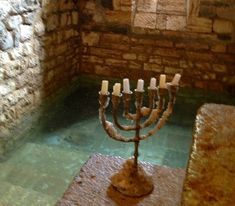 For purification, water immersion can be traced back to the time of Moses, when God told him to speak with the people of Israel and tell them the social (or civic) laws about bodily discharges for both men and women. All are contained in the Old Testament in the book of Leviticus. These laws can be read at Leviticus 15:2–18 (for men) and Leviticus 15:19–30 (for women).
For purification, water immersion can be traced back to the time of Moses, when God told him to speak with the people of Israel and tell them the social (or civic) laws about bodily discharges for both men and women. All are contained in the Old Testament in the book of Leviticus. These laws can be read at Leviticus 15:2–18 (for men) and Leviticus 15:19–30 (for women).
Some of these purification laws are still practiced today by many Jews. Take the tradition of using the mikvah (a ritual immersion bath) for instance, to achieve ritual purity, especially after a woman’s monthly cycle. This ritual cleansing bath can bring both husband and wife closer to God and heighten their spirituality. It can be a monthly experience that includes prayer and renewed faith — a new start, as we say. (For a deeper study of ritual cleansing, see “Menstrual Periods in the Bible and Other Personal Issues” listed in References & Notes.)3
John the Baptist
Immersion for the purpose of a ritual consecration or spiritual rebirth has a long history, also. Although historical references go as far back as Babylonian times,4 most are during the second temple period5 (ending in 70 AD) and later, and they seemed to have been particularly significant in the rites of the Essenes.6
John the Baptist has often been linked to the private community of Essenes during Jesus’ time — a group which originated about 100 BC. They were extremists and cult-like and lived an abstinent lifestyle with daily acts of ceremonial cleansing. Members taught internal repentance that must accompany an external act. Some scholars believe this was the precursor of John’s more public baptism methods,7 which demanded not only personal repentance, but a public demonstration of a new beginning.
Jesus and John the Baptist were related, possibly cousins, but the New Testament does not record them being together before John baptized our Lord. But, let’s face it, they lived close and there was about thirty years of unknown history before this baptizing event, so it is reasonable to expect they had heard things or met sometime beforehand, and knew much about each other.
John had an exotic and radical personality, but it is obvious Jesus had respect for him. Jesus seemed to know that John was the voice mentioned in Isaiah. “A voice cries out: ‘In the wilderness prepare the way of the LORD, make straight in the desert a highway for our God’,” (Isaiah 40:3, ESV).8 “Isaiah saw a general picture of someone making preparation for the Lord’s coming,” and the writers of the New Testament Gospels “connect these words with the ministry of John the Baptist” (see Matthew 3:3, Mark 1:3, Luke 3:4).9
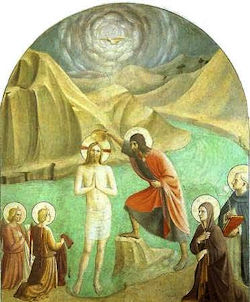 Jesus, of course, was baptized by John, who was preaching repentance (turning away from the old life, and beginning a new life). The baptizer’s call was for one to repent, then publically announce that decision. Obviously our Lord did not need to repent of anything, being the only sinless human since the fall of Adam and Eve in the Garden of Eden. Even John recognized this fact (Matthew 3:13-14). Some say that Jesus was baptized to bear our sins, but that isn’t quite right. For to do that, he would first have to die for real, not just symbolically.
Jesus, of course, was baptized by John, who was preaching repentance (turning away from the old life, and beginning a new life). The baptizer’s call was for one to repent, then publically announce that decision. Obviously our Lord did not need to repent of anything, being the only sinless human since the fall of Adam and Eve in the Garden of Eden. Even John recognized this fact (Matthew 3:13-14). Some say that Jesus was baptized to bear our sins, but that isn’t quite right. For to do that, he would first have to die for real, not just symbolically.
So, why did he get baptized? It was necessary for a couple of reasons. First, he wanted to demonstrate to his Father that he was ready to serve him, no matter what it would take. At this event, God downloaded all the information Jesus needed to complete his mission on earth, but Jesus needed to announce publically the new beginning he was about to undertake. And what is the content of this new undertaking? It was to do the will of his father.
Second, to fulfill all legal and moral principles, as he said to John the baptizer, “it is fitting for us to fulfill all righteousness” (Matthew 3:15b). Jesus needed to be baptized to take on roles of both king and priest — the order of the Melchizedek priesthood10 (see Psalm 110:4, also Exodus 29:1-7). To eventually offer himself as a sacrifice for our sins, Jesus would need to have the legal privilege to enter the inner sanctum of God’s temple on the Day of Atonement. As the High Priest (kohen gadol), he would be authorized to offer a sacrifice for sins.11
Human Complications
For us, as sinners, what is baptism all about? It is a symbolic public demonstration of one’s new spiritual and personal change in life and acknowledges acceptance of Jesus as the Messiah.12 But, one would think it needs to be done only after someone makes the decision to do so, which is much too soon for an infant or small child. When done by a mature adult, the change would be significant, but the demonstration would be simple — allegorically wash away the old and proceed with the new.
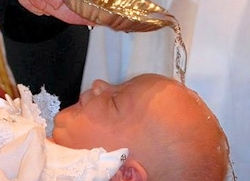
Just as circumcision served as a visible external marker of inclusion in the covenant community of Israel, so baptism serves as the public sign and seal of a person’s solidarity with Christ and participation in the new covenant community of faith, which encompasses both Jewish and non-Jewish people.13
Today this simplicity has been stripped away and replaced with complexity; today we must follow certain specific rules and procedures and, sometimes, even be tested before being allowed this rite. One can not have a personal relationship with our Lord, if it is someone else making all the decisions for us. The Churches’ tangle of rules and regulations introduce a layer of control between us and our Lord.
Over time, this original display of conversion or commitment has taken on a life of its own and church leaders feel they must have complete control over who, where, when, and how someone can be baptized. There are even formulas of words, and recipes mandated for procedures, that must be recited or performed in specific fashion, or the rite is not acceptable. The church, in many cases, will invalidate some baptisms if even a single word is used incorrectly.
“For centuries, the baptismal formula in the Roman Catholic Church has been: ‘I baptize you in the name of the Father, and of the Son, and of the Holy Spirit’.” If it isn’t exactly like this, then it isn’t valid. In several cases, Priests were saying “We baptize you . . .” instead of “I baptize you . . .” and it caused a great uproar at the highest levels of church government. In other words, “it was not only against the rules, it did not work. The person is not baptized and must be baptized again using the correct formula.”14
The Catholic church also says it is necessary to use the word ‘baptize’ and it is obligatory to mention the separate persons of the Holy Trinity. “This is the command of Christ to His Disciples, and as the sacrament has its efficacy from Him who instituted it, we cannot omit anything that He has prescribed.” And they backup this opinion with a list of Church fathers to prove it is law: Tertullian, Justin Martyr, Origen. Augustine, and others. Without the proper formula, there is no remission of sin and no validity of the baptism.15 I guess it is a matter of their way, or no way.
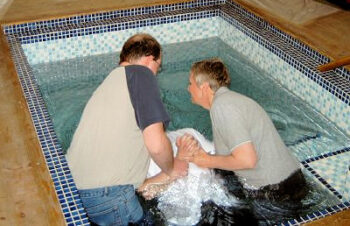 I mention the Catholic church, as a historical example, but there were other Christian organizations that went so far as to demand a redo of Baptism, for one reason or another. All denominations must accept some blame for twisting this simple ceremony into many shapes. And there are some that say baptism is essential to salvation, even though Paul made a distinction between the two, when he wrote, “Christ did not send me to baptize but to preach the gospel,” (1 Corinthians 1:18). And in the book of Romans, Paul said that the Gospel is the real power for salvation (see Romans 1:16).16
I mention the Catholic church, as a historical example, but there were other Christian organizations that went so far as to demand a redo of Baptism, for one reason or another. All denominations must accept some blame for twisting this simple ceremony into many shapes. And there are some that say baptism is essential to salvation, even though Paul made a distinction between the two, when he wrote, “Christ did not send me to baptize but to preach the gospel,” (1 Corinthians 1:18). And in the book of Romans, Paul said that the Gospel is the real power for salvation (see Romans 1:16).16
The Trinity idea causes much confusion in the baptism process. We won’t get into all the variations of Trinitarian concepts, but mentioning just a few will demonstrate the problem. Most denominations that preach the Trinity say that God is both three persons and one person. Others say that God just changes his mode of appearance (modalism). Some claim that each of the three persons is a distinct god (tritheism). Some even debate among themselves as to if their belief is pro-Trinitarian or anti-Trinitarian. And, of course, there are Christians that refute any type of Trinity, by believing that there is one God Almighty, one Son of God under direction of the Father, and a heavenly ‘force’ or ‘power’ called the Holy Spirit.
Is the Trinity a false addition to Matthew’s baptism formula?
Now, there is some question about the validity of the baptism scripture in Matthew, which is considered the ‘Great Commission’. After his resurrection, Jesus said, “Go therefore and make disciples of all nations, baptizing them in the name of the Father and of the Son and of the Holy Spirit, teaching them to observe all that I have commanded you. And behold, I am with you always, to the end of the age,” (Matthew 28:19-20).
The argument has been, do the words “in the name of the Father and of the Son and of the Holy Spirit” even belong in this scripture? This statement is often used to support the doctrine of the Trinity, so there has always been some disagreement about its status.
Some say that this particular scripture is no more a formula than Acts 2:38, which says, “Repent and be baptized every one of you in the name of Jesus Christ for the forgiveness of your sins, and you will receive the gift of the Holy Spirit.” (Also see Acts 8:16, and 19:5.) Many people reasonably feel that there is no precise formula mentioned. Combined, there is only a statement of facts: repent and publically symbolize washing away the old and beginning the new, by the authority of Jesus Christ, so one can receive the gift of God’s Holy Spirit.
Do all ancient Bible manuscripts mention ‘Father, Son, Holy Spirit’ in Matthew 28:19–20? Most Bibles today are derived from the Latin Vulgate translation of the 1500s, which was made the official authoritative Church edition, at the Council of Trent.17 But a document called the Shem Tov may shed some light, as to if part of Matthew 28 had been added at a later date.

The Shem Tov (or Shem-Tob) is possibly the oldest Bible document. It is actually written in Hebrew, rather than Latin or Greek and is generally dated within the first four centuries AD. It contains many readings not found in any Christian codices, possibly because its transmission was preserved by Jews, independent from the evolving Christian community.18 It would have been less likely altered by Church leaders or scribes with certain agendas.
This Shem Tov document for Matthew 28:18–20 reads: “Jesus drew near to them and said to them: To me has been given all power in heaven and earth. Go and (teach) them to carry out all the things which I have commanded you forever.”19 My personal thought is that this appears to be in harmony with the message that other scripture quotes.
It should be mentioned that this is not the only verse questioning scripture authenticity found within the Bible, as there are many. Whether something is added, or subtracted, it is sometimes frustrating to try and figure out what happened. Many times we must dig deep to uncover truth.
Not all Christian denominations baptize members. Most view the ritual as necessary, while some few believe baptism is only an inward sacrament and not a necessary formal religious ceremony.20 Remember, even the criminal crucified along with Jesus was promised entrance into his kingdom, even though he received no type of baptism ceremony.
But, when it is requested and performed, it should be with flowing water, as it was during the days of Christ. Rivers and creeks were appropriate, even the sea. Also, enclosures such as the Jewish mikvah were acceptable. The idea was to flush away the old, not taint a tub or bowl of still water.
Immersion was most common, but there are some writings from the ancient Church indicating it was the water, not the method, that was most important. The early instructions book, the Didache,21 provided the pouring of water for situations where immersion was not practical.
Tertullian (196-212 AD), allowed for various approaches, even if not consistent with tradition, and Cyprian (about 256 AD) “explicitly stated that the amount of water was inconsequential” and defended various other practices.22 Probably these practices began at the location of the flowing water, but slowly moved into Churches where stored water in containers was “blessed” by priests and others, for baptismal purposes.
So, how should baptism be performed today?
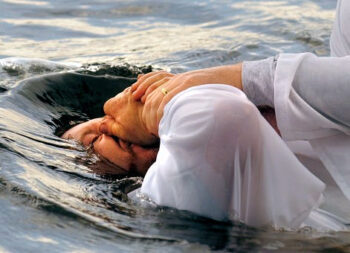
The ceremony should be simple. It should use flowing water. Immersion is preferred, but not mandatory. But what to say? Jesus’ words at Matthew 28:18 are now mandatory in most denominations, but I will add a bit of my own opinion, here. I believe that the phrase ‘in the name of the Father and of the Son and of the Holy Spirit’ was not part of the original text. Why?
Well, it is only mentioned that way in the Bible but once, and there is evidence that it may have been added later. If it was demanded by Jesus, would not his followers be careful to follow his example and have it recorded? Also, Jesus had full authority and it was his own human example that Christians were to follow, so it is his name that describes the authority. Like prayer, it is said by his authority or ‘in his name’. Besides, the Trinity doctrine was not even thought of in the early Church and is not mentioned in the Bible. (For more on the Trinity, see the article “Can you be a Christian and Not Believe in the Trinity?” listed in References & Notes.)23
I believe the Bible is God’s word, and if I have a ‘gut feeling’ about a particular scripture not being authentic, I search for truth and pray for God’s guidance. In this case, I believe I’ve found it. So far, at least — if I find better evidence tomorrow, I may change my mind. But, today, the manuscript mentioned earlier, the Shem Tov document, is a better fit for Jesus’ actual words. “To me has been given all power in heaven and earth. Go and (teach) them to carry out all the things which I have commanded you forever” (Matthew 28:18-20, Shem Tov).
There are many man-made creative ways that Christian denominations lead their congregants through the baptism maze. If you are fine with what is happening in your church, you have already made your decision. And that is okay. Being comfortable is good, besides what really matters is what is in your mind and heart.
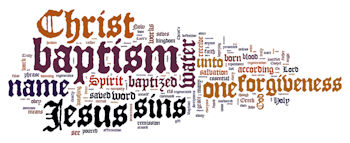 Let’s get past all the gobbledygook.24 There is no formula needed, so exact words are not necessary. If you want baptism and want something said, then go by what the apostles said; that seems good enough to me. All that would be necessary is repentance, following Christ’s teaching, and public baptism to announce the new path in life. If you are sincere, the gift received is the Holy Spirit of God.
Let’s get past all the gobbledygook.24 There is no formula needed, so exact words are not necessary. If you want baptism and want something said, then go by what the apostles said; that seems good enough to me. All that would be necessary is repentance, following Christ’s teaching, and public baptism to announce the new path in life. If you are sincere, the gift received is the Holy Spirit of God.
Remember baptism is not taking a part of something, but a rite of passage to something. Some people look at repentance, and a change of lifestyle to following Christ, as a heavenly contract. If so, they can also look at baptism as the signature which seals the terms of that contract. You agree and you receive the gift of the Holy Spirit.
Peter’s words in Acts, or other similar verses, seems a logical approach to this problem. “Repent and be baptized . . . in the name of Jesus Christ for the forgiveness of your sins,” (Acts 2:38a). Once the person agrees that they have repented (a change of mind, including acceptance of the Gospel)25 and wants to be baptized, it should be done by authority of Jesus. Let’s return the simplicity to our Lord’s Great Commission. I’m not telling anyone what to believe — I’m only telling everyone what I believe. “And now why do you wait? Rise and be baptized and wash away your sins, calling on his name” (Acts 22:16).
End Note
The following song fits the theme of this article. A country artist, Randy Travis, sings the song, ‘Baptism’. This song is sometimes called ‘Down with the Old Man’ and was written by Mickey Cates in 1999. It is about a Christian’s baptism in an eastern Tennessee river. Selected lyrics are below and a music video is listed in References & Notes.26
 The summer breeze, made ripples on the pond
The summer breeze, made ripples on the pond
Rattled through the rings and the willow trees beyond
Daddy in his good hat, mama in her Sunday dress
Watched in pride, as I stood there in the water up to my chest
I sank my toes into that East Tennessee mud
And it was down with the old man, up with the new
Raised to walk in the way of light and truth
I didn’t see no angels, just a few saints on the shore
![]()
Copyright © 2020, Dr. Ray Hermann
OutlawBibleStudent.org
→ Leave comments at the end, after ‘References & Notes’.
Your email address will NOT be published. For more information, click on “The Fine Print” on the top menu bar.
References & Notes
- Merriam-Webster’s Collegiate Dictionary, 11th ed., (Springfield, MA: Merriam-Webster, Inc., 2003).
- Baptism: from the Greek noun, βάπτισμα baptisma.
“Baptism”, (Wikipedia, Wikipedia Foundation Inc, 17 December 2020), https://en.wikipedia.org/wiki/Baptism - Hermann, Ray, “Menstrual Periods in the Bible and Other Personal Issues”, (The Outlaw Bible Student, OBS, 8 March 2020), https://outlawbiblestudent.org/menstrual-periods-in-the-bible-and-other-bodily-discharges/
- “History of baptism”, (Wikipedia, Wikipedia Foundation Inc., 30 November 2020), https://en.wikipedia.org/wiki/History_of_baptism
- second temple period: the six hundred years prior to 70 AD. This period begins when Jews in Judaea, Mesopotamia, and Egypt found themselves under Persian rule, and they were able to rebuild the temple in Jerusalem. This second temple was destroyed in 70 AD.
Weitzman, Steven P., and DeBold, R. Timothy, “The Second Temple Period”, (Oxford Bibliographies, Oxford University Press, 29 August 2012), https://www.oxfordbibliographies.com/view/document/obo-9780199840731/obo-9780199840731-0005.xml - “Baptism”, (Encyclopædia Britannica, Encyclopædia Britannica, Inc., 23 April 2020), https://www.britannica.com/topic/baptism
- Osborne, Grant R., in Baker Encyclopedia of the Bible, Walter A. Elwell, (Ed.), (Grand Rapids, MI: Baker Book House, 1988), vol. 1, p. 257.
- Unless otherwise indicated, all scripture quotations are taken from The Holy Bible, English Standard Version (ESV), ©2001 by Crossway, a publishing ministry of Good News Publishers. The text has been used by permission. All rights reserved.
- Smith, Gary, in CSB Apologetics Study Bible, (Nashville: Holman Bible Publishers, 2017), p. 855.
- Melchizedek priesthood: obtaining a dual role which combined the positions of king and priest.
Hess, Richard S., and Carroll (Rodas), M. Daniel, (Eds.), Israel’s Messiah in the Bible and the Dead Sea Scrolls, (Ada, MI: Baker Academic Publishers, 2003), p. 67. - ”High priest”, (Encyclopædia Britannica, Encyclopædia Britannica, Inc., 18 May 2020), https://www.britannica.com/topic/high-priest
- Page, Thomas Ethelbert, The Acts of the Apostles, Classic Commentaries on the Greek New Testament, (London: Macmillan, 1897), p. 93-94.
- Barry, John D., et al., Faithlife Study Bible, (Bellingham, WA: Lexham Press, 2012, 2016), Acts 2:38.
- Reese, Thomas, “Vatican causes chaos by invalidating baptism formula”, (RNS, Religion News Service, 15 September 2020), https://religionnews.com/2020/09/15/vatican-causes-chaos-by-invalidating-baptism-formula/
- “Baptism”, (Catholic Encyclopedia, Catholic Online, retrieved 20 December 2020), https://www.catholic.org/encyclopedia/view.php?id=1463
- Porter, Stanley E., in CSB Apologetics Study Bible, (Nashville: Holman Bible Publishers, 2017), p. 1350.
- The nineteenth ecumenical council (ended in 1563). Its main object was the definitive determination of the doctrines of the Church in answer to the heresies of the Protestants.
Kirsch, Johann Peter, in The Catholic Encyclopedia: An International Work of Reference on the Constitution, Doctrine, Discipline, and History of the Catholic Church, (New York: The Encyclopedia Press, Inc., 1907–1913), volumes I – XV. - Karim, Kaleef K., “Trinity: Examining Authenticity Of Matthew 28:19″, (Discover the Truth, 5 August 2013), https://discover-the-truth.com/2013/08/05/trinity-investigating-the-authenticity-of-matthew-2819/
- Ibid.
- Byer, Beverley, “Which Religions Practice Baptism? Which Do Not?” (Owlcation, 29 July 2019), https://owlcation.com/humanities/Which-Religions-Practice-Baptism-Which-Do-Not
- Didache: the book known as ‘The Lord’s Teaching Through the Twelve Apostles to the Nations’. It is a brief early Christian treatise written in Greek. This document detailed what the apostles taught to the Gentiles (60-150 AD).
- Slade, Darren M., “The Early Church’s Inconsequential View of the Mode of Baptism” (American Theological Inquiry Journal, Minneapolis, MN: 15 August 2014), vol. 7, no. 2, pp. 21–34.
A copy of this document is also available on the Internet Archive ‘WayBackMachine’: https://web.archive.org/web/20140903085434/http://atijournal.org/ATI_Vol7_No2.pdf - Hermann, Ray, “Can you be a Christian and Not Believe in the Trinity?” (The Outlaw Bible Student, OBS, 28 July 2018), https://outlawbiblestudent.org/can-you-be-a-christian-and-not-believe-in-the-trinity/
- gobbledygook (gŏb əl-dē-gook): nonsense; meaningless; complex; incoherent; incomprehensible. A fairly common expression in the United States, but I’m not sure about its use elsewhere.
- Jamieson, Robert; Fausset, A. R.; and Brown, David, Commentary Critical and Explanatory on the Whole Bible, (Oak Harbor, WA: Logos Research Systems, Inc., 1997), vol. 2, p. 176.
- “Baptism”, (Live at Indiana Roof Ballroom, Indianapolis), Artist: Randy Travis, 2001, CD/DVD: Freedom Band, (licensed to YouTube by Gaither Music Group, Sony ATV Publishing, ASCAP, more) – MUSIC VIDEO: https://youtu.be/mdPGDBZdXuk
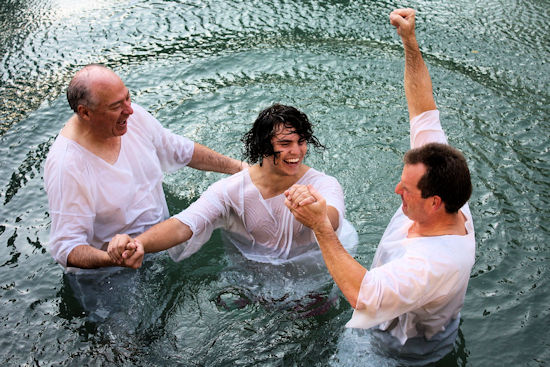

Thank you for being so daring to take the time to tackle a subject that most wouldn’t dare touch.
I have always wrestled with “Father, Son and Holy Spirit” “formula” of baptizing because when I read the baptismal accounts throughout the Acts of the Apostles not once was a triune/trinitarian method mentioned or performed. In any case your very well written and researched article gives me the evidence to support my belief and footnote #18 goes even further to substantiate it.
Thanks again and I look forward to reading many more of your articles. both the serious and the not-so-serious.
Thank you for reading this article and taking the time to contribute a comment. Your kind words are appreciated. I am glad you found this study of value.
thank you for explaining this problem. I was never much of a trinity believer and always thought the trinity phrase in Matthew 28 did not belong there.
That you read this article and took the time to comment is appreciated
Why do you believe some unknown piece of paper that has is not accepted as part of the bible and denounce someting accepted by our church leaders that carefully saved the bible for 2000 years. Don’t change gods word.
Thanks for reading this article and making a comment about the Shem Tov (Shem Tob) manuscript, however . . .
The Shem Tov Hebrew Gospel of Matthew is not some outlandish or unimportant discovery. It is not popular, only because it demonstrates the Trinity theory is not, necessarily, supported upon a sound foundation.
This record of Matthew is accepted by scholars as an authentic biblical manuscript. Several copies have been found, but it gets its name from the first collection of the eighteen pages by the Jewish physician whose name the document carries (Shem Tov) in the 1300s. It was translated by George Eulan Howard, Jewish scholar (Hebraist) at University of Georgia in the United States. His book Hebrew Gospel of Matthew, was published by Mercer University Press.
Most important is that it is not a translation from Greek, but from Hebrew. Also, this Hebrew version is easier to read than the various Greek versions. Wording is similar to other Hebrew scripture and is comparable to the way Jesus spoke. This text does not contain the inaccurate remarks placed within conversations of other manuscripts.
It is known that much of the record of Jesus Christ began to be changed early on. And this problem was mentioned in scripture. Peter makes a statement, not about Matthew, but about Paul when he said: “Some things Paul writes are difficult to understand. Irresponsible people who don’t know what they are talking about twist them every which way. They do it to the rest of the Scriptures, too, destroying themselves as they do it. But you, friends, are well-warned. Be on guard lest you lose your footing and get swept off your feet by these lawless and loose-talking teachers,” (2 Peter 3:16-17, ‘The Message’ translation).